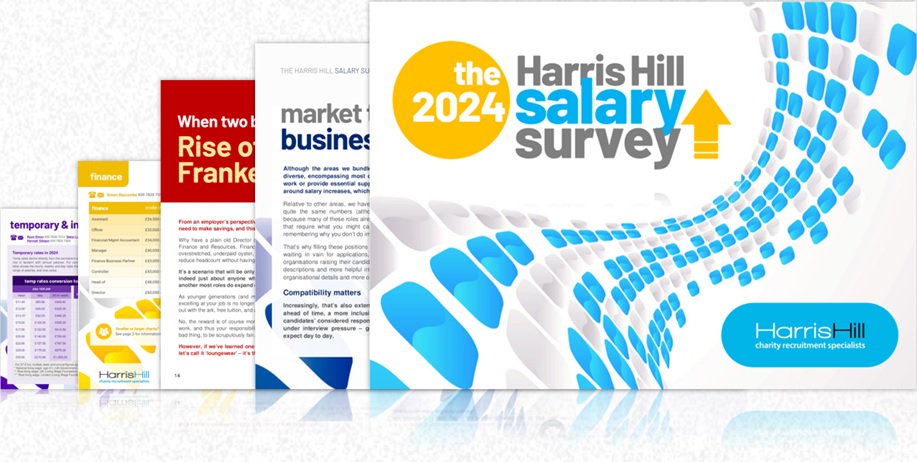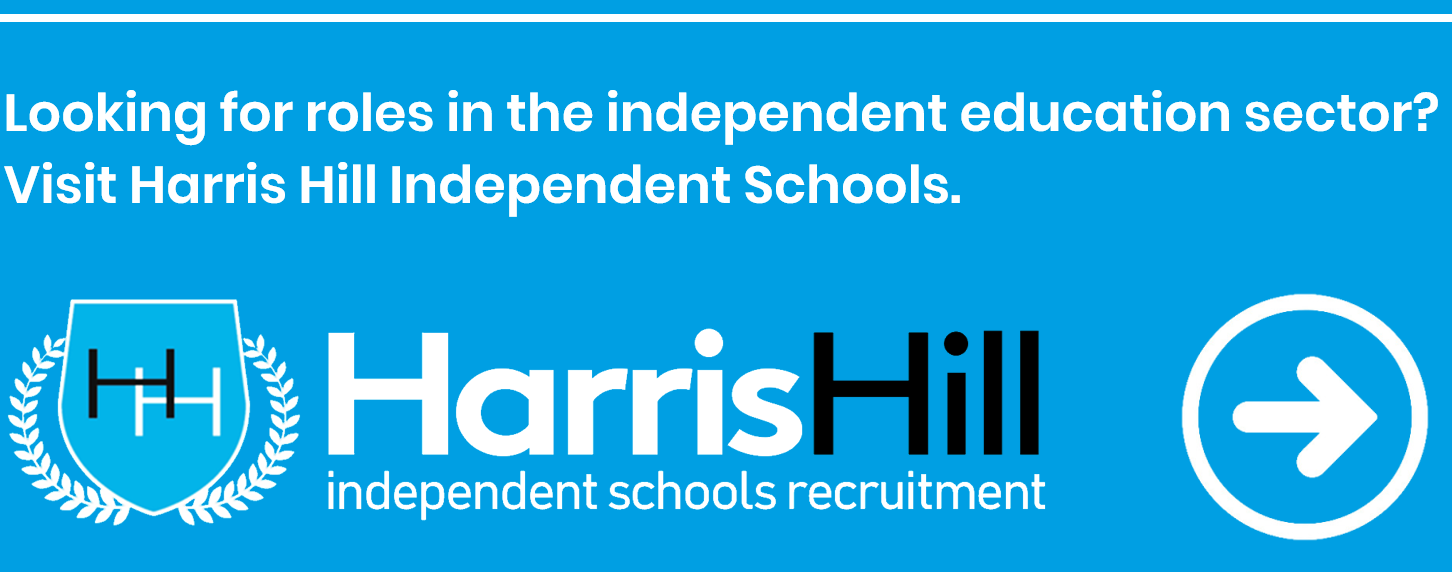Here you'll find previous editions for reference, to view or download in pdf format.

Salary Survey archive
The Harris Hill Salary Survey
2023 | | 2022 | | 2019 |
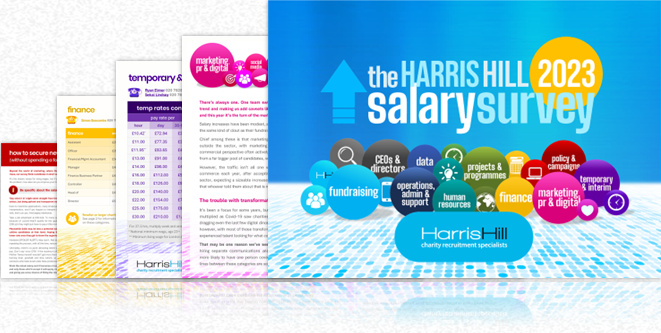 | | 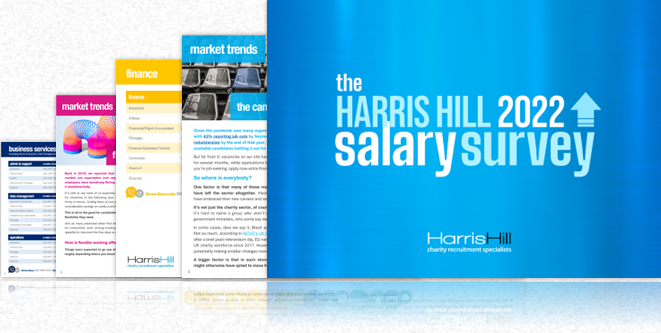 | | 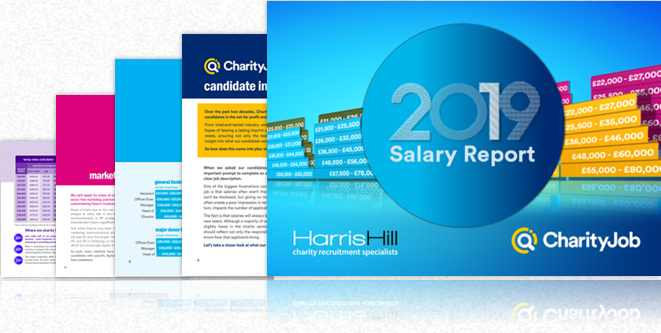 |
A rare year in which demand for candidates far exceeded supply, driving sizeable salary increases in many areas, and leading us to investigate what organisations without the budget to compete on salaries can do to attract new talent. | | The 2022 survey is our first post-pandemic review of salaries, showing the impact of that time on remuneration in the sector, looking at reasons for the continued candidate shortage, and exploring the new pandemic-inspired essential: flexible working. | | For our 2019 survey we teamed up with market-leading job board CharityJob, bringing fresh insight and a vast wealth of information to the 2019 Salary Report: our biggest and most comprehensive to date, and the definitive guide to charity sector salaries. |
2018 | | 2017 | | 2016 |
| |
NB: Due to the Covid-19 pandemic there was no edition produced in 2020 or 2021.
-
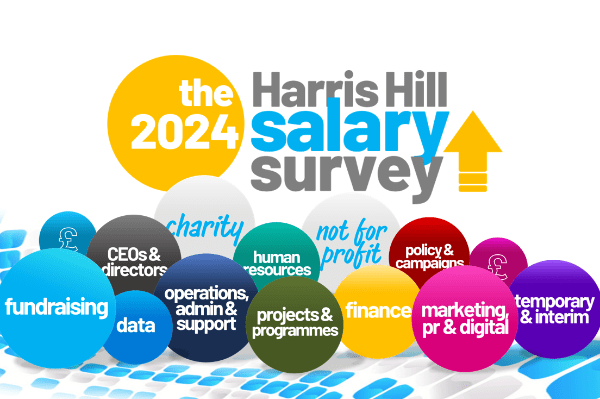
The Harris Hill Salary Survey 2024
Check out our latest guide to salaries in the UK charity sector: are they keeping up with inflation and what does it mean for fundraisers, CEOs, marketers, temps and more?
Find out here, plus we explore the growing trend for rolling two jobs into one: smart cost-saving measure or a recipe for burnout?
-

How to negotiate a pay rise in the charity sector
Requesting a raise in the charity sector can be uniquely awkward: feeling undervalued helps no-one, but does more for you mean less for those in need?
Guest writer Nicola Greenbrook is here to tackle this tricky dilemma.
-
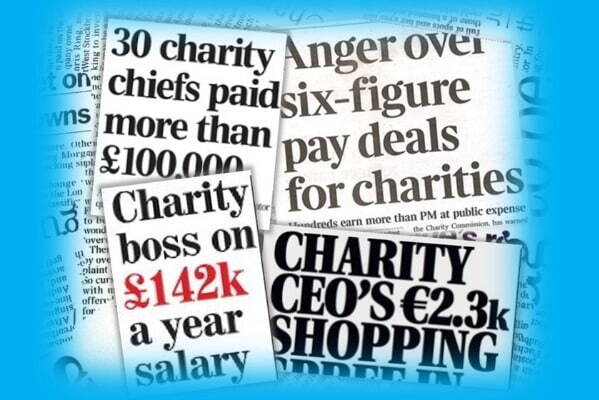
The truth about charity chief executives
Every so often we're invited to be incandescent about the salaries of charity executives, but what's the truth behind the tabloid tales?
Jenny Hills of our executive practice explains what charities really pay their CEOs, and why.
Advice, news, events and specialist insight from the Harris Hill Blog
-
![]()
2025 Salary Survey: Charity CEO salaries and executive trends
How much do charity CEOs get paid?The short answer is that although charity leaders tend to earn considerably less than their commercial counterparts, pay still varies enormously, depending on factors like the size and complexity of the charity's operations, its annual income, and the scale of the challenge facing the incoming CEO.Every organisation is unique, with its own particular priorities and requirements, making every CEO position an individual case, with a salary that reflects the particular context and circumstances of the role.You'll find more detail on this below, but as such, simply quoting averages would tell you next to nothing about the appropriate pay for any specific role.The people who can tell you that, however, are our hugely experienced Executive Search team, each of whom has specialised in recruiting charity CEOs, chairs, trustees and other board-level bods (very successfully, we might add) for well over a decade with us alone.If you need any help or advice on a move or appointment at this level, don't hesitate to give them a call, but meanwhile here's what they had to say about the shape of the current market, in our 2025 Salary Survey.Executive recruitment trends in the charity sectorFor all we hear of soaring CEO pay in the business world, here in the charity sector it remains reassuringly tethered to the ground, with the pay differential between the average CEO and the average worker running at no more than 4:1. That compares with an average among FTSE100 companies of more than 150:1, somewhere beyond ‘disproportionate and excessive’, in the region of ‘openly mocking your own workforce’.Charities’ obligation to publish the salaries of their top earners may have something to do with this, but in choosing not to pursue the far greater rewards available elsewhere, charity chiefs show that claims of being ‘only in it for the money’ are a long way wide of the mark.There’s certainly been little change in the last year, with CEO salaries for all but the very biggest household-name charities peaking at around £120k, although this remains relatively rare in itself.If there’s been any movement, it’s at the bottom of the bracket where you’re now unlikely to succeed in hiring a CEO for less than £60k.What are charity CEOs looking for?Salaries do have a clear impact on the level of interest in CEO vacancies, with those paying six figures attracting up to three times as many applications as those at the lower end. Yet it’s not the factor with the greatest influence in that respect. That would be the location, with remote-based roles pulling in up to five times more applications than a typical site-based position. To some extent, that’s because they’re relatively rare, given the challenge of leading effectively without at least some in-person presence.Whether organisations are based in or outside London also has an impact on pay, but beyond that there’s little difference between UK regions. At this level, leadership salaries for most organisations – hospices being a good example – need to be nationally competitive. However it’s increasingly rare for a CEO to relocate purely for the position: those who do so normally have unrelated personal reasons for making the move.What else attracts senior executive candidates?Flexible working of some kind is essential, while other benefits such as pension schemes make a real difference too, and can dramatically improve the appeal of roles with salaries at the lower end. When there’s no room to raise the salary, some organisations are looking at sweetening the deal by making the CEO a part-time post, but it’s not necessarily the candidate magnet they might have hoped. Applicants question whether the role can ever truly be part-time, expecting (perhaps rightly) that they would soon find themselves working full-time anyway to get everything done, but on a part-time salary. Generally speaking, however, we’re finding charity boards increasingly clued-up about the market and what they can realistically expect, which makes for a smoother and more effective search. What can hamper the recruitment process is a lack of alignment between trustees on key priorities, such as whether they’re looking for 2-3 years of strong leadership or someone to steer the ship for the next decade and beyond. Is leadership experience more or less important than a record of getting results? Unanimity on questions like these goes a long way to finding the right individual at the first time of asking.Harris Hill Executive SearchWhat determines the salary level for a charity CEO?While they might share a title, the job of leading a local 20-person charity is clearly something very different from running a global organisation of thousands, delivering multiple initiatives around the world. Salaries span an equally wide range as a result, each reflecting the scope and scale of the role in question, but these are the six key factors likely to have the biggest influence on the final figure.If you'd like to know more about salaries or the market, or for help and advice with any current or future requirements at this level, please contact our Executive Search team via the details below, call 020 7820 7300, or email executive@harrishill.co.ukJenny Hills DirectorNick Shanks DirectorAled Morris CEO020 7820 7321 ● Email Jenny07766 538575 ● Email Nick020 7820 7301 ● Email AledSearch charity jobsView the Salary SurveyRead the Harris Hill Blog
-
![]()
2025 Salary Survey: temps market trends
Tough economic times have certainly had an impact on the number of permanent hires that charities have been able to make this year, but what about temporary and interim positions?Here's what our Temps specialists had to say about the trends they're seeing in the market, in our 2025 Salary Survey.It says everything about the current market that this is the only one of our specialist areas to have seen more jobs this year than last — in fact the highest proportion (relative to permanent roles) for many years.Much of that increase has come from finance departments, seeking additional help to ensure their organisations are financially robust, while we’ve also seen more openings in HR, particularly related to restructuring, where it can make more sense to hire a term-limited contractor than someone who’ll need to have a difficult conversation with themselves once their work is done. In many other cases however, the rise in temporary roles simply reflects the growing number of organisations in too precarious a position to offer anything more permanent. Fortunately for those organisations, whether by choice or as a result of redundancies within the sector, there’s been a similar rise in the number of candidates looking for temporary work, although it’s fair to say that not all are equally suited to it. As such, much of the help we’re currently providing is less around seeking out potential candidates than saving clients from spending countless days sorting through them. Candidate availability very much depends on the role however, and perhaps the most challenging to find in the past year have been those with events experience. This is likely to be at least partly a hangover from the Covid-19 pandemic, when gatherings of any kind were off the table for some time, forcing events professionals into other fields, where many have since remained. Meanwhile, if other vacancies are proving challenging to fill, it’s generally due to the rates. Salaries for temp positions essentially track their permanent equivalents, and while they haven’t increased enormously (even over a decade), they have changed, so those organisations whose temp rates haven’t moved with the times face a long wait for candidates, drawn from a much more limited pool. However a strong point in favour of the charity sector for temps is that hybrid working (typically two days per week on site) is still very much the norm, with little sign of the push back towards the office that’s happening elsewhere. And among temp employers at least, it’s been encouraging to see a consistent rise in requests for candidate details to be anonymised (to reduce the potential for bias), reflecting greater consideration for inclusivity in their recruitment process.Temp rates conversion toolRates for temporary roles are simply the hourly equivalent of what the role would pay as a permanent salary, so they move in line with those.If permanent salaries are what you're used to however, it's not always easy to tell how generous or otherwise an hourly rate is at first glance. So to save you whipping out the calculator every time, our table shows what a range of hourly rates equate to as an annual salary, along with the equivalent weekly and day rates.Hourly rateEquivalent day rate (7 hrs)Equivalent week rate (35 hrs)Equivalent annual salary£12.21*£85.47£427.35£22,222£12.60**£88.20£441.00£22,932£13.85***£96.95£484.75£25,207£15.00£105.00£525.00£27,300£17.50£122.50£612.50£31,850£20.00£140.00£700.00£36,400£22.50£157.50£787.50£40,950£25.00£175.00£875.00£45,500£30.00£210.00£1,050.00£54,600- For a 37.5-hour week, multiply the day, week or annual figure by 1.071* The national living wage for age 21+, as set by the UK Government.** The real living wage needed in the UK, as calculated by the Living Wage Foundation*** The real living wage needed in London (Living Wage Foundation)For more on the market, or if you'd like our help with a temporary or short term recruitment need, please contact our temps specialists Ryan Elmer, Sekai Lindsay or Hannah Gibson who'll be happy to help.Meanwhile you can find all the figures for all departments in the full 2025 Salary Survey here, or for any other queries, you can also contact our specialists, call us on 020 7820 7300 or email info@harrishill.co.ukSearch charity jobsView the surveyRead the Harris Hill Blog
-
![]()
2025 Salary Survey: finance market trends
Say you work in finance and many will imagine a world of six-figure salaries, baffling spreadsheets, detached houses in the Home Counties and a statistically inexplicable number of people called Steve. Working in charity finance however, is – baffling spreadsheets aside – a rather different story, but with their finger on the pulse and their ear to the ground at all times (we should really get them some chairs), our finance specialists are perfectly placed to bring you up to speed on the latest twists and turns. Here’s what they had to say about remuneration and recruitment trends in the current market, in our 2025 Salary Survey. Finance roles have traditionally been among the better-paid charity jobs, carrying a premium in recognition of the extra study required for accounting qualifications. However, employers seem increasingly reluctant to honour this, leading to a fairly flat year for those in charity finance, with only limited increases, largely at the senior end of the market. Nonetheless, economic uncertainty has certainly driven a boom in one thing: charities finding creative ways to meet their staffing needs without actually raising the budget. One of these methods is a scattershot approach, posting the role at the desired rate through multiple agencies, job boards, social media, their own channels – extra admin be damned – and simply waiting it out until someone is desperate enough to accept it. Until recently, this would have been a recipe for certain regret, but with more candidates in the market and many others at risk of joining them, there’s now more chance of an eventual result, even if it’s nobody’s ideal outcome. Another tactic is to underplay the role’s importance, in a bid to justify a lesser salary. We’re seeing an increasing number of roles advertised, for example, as a Finance Manager, which on closer inspection have all the responsibilities of a Head of Finance, just not the remuneration. It’s a little sneaky, and applicants would be well advised to read through job descriptions thoroughly rather than relying on the title - but faced with such existential financial challenges, it’s hard to begrudge charities trying to cut every possible corner to keep costs down. In a similar vein at more junior levels, we’re seeing more and more openings for Finance Officers who, rather than being supported by a Finance Assistant, are required to perform that role as well, making for some very long lists of responsibilities that candidates find wildly out of proportion to the salaries on offer. There’s even some of that at the top too, in the shape of Finance Directors increasingly functioning as a secondary CEO but without, of course, the rewards. It’s a sign of the extreme pressure on budgets that we’re even seeing candidates being offered less than their current position, hoping that the role will appeal for other reasons, but it’s vanishingly rare that those reasons are compelling enough for this tactic to bear fruit. Or indeed finance professionals, who are significantly better at the job. Meanwhile, with more candidates competing for fewer vacancies than we’ve seen for several years, many organisations have made the application process more demanding, requiring things like presentations and assessments on top of the regular CV. However, having landed good jobs with less effort in the past, applicants are increasingly unwilling to jump through additional hoops, so this can deter some of the very best candidates. Those with little choice will still apply, but those who can take their pick of employers will simply pick somewhere else. Our advice? Maybe reconsider the assault course. For more on the market, or if you'd like our help with a recruitment issue in this field, please contact our finance specialists Simon Bascombe or Joshua Liveras who'll be happy to help.Meanwhile you can find all the figures for all departments in the full 2025 Salary Survey here, or for any other queries, you can also contact our specialists, call us on 020 7820 7300 or email info@harrishill.co.ukSearch charity jobsView the surveyRead the Harris Hill Blog
-
![]()
2025 Salary Survey: business services market trends
The roles we group under ‘Business Services’ aren’t about raising funds or raising profile, but about delivering an organisation’s work – including operational staff at all levels, project managers, programme leaders and all the admin, data and support staff in less visible roles that are nonetheless essential to getting things done. So what’s happening in the recruitment market for those working in these areas? Here’s what our specialists had to say in our 2025 Salary Survey. Market trendsSalaries make a difference of course, but in these areas, the factor with the biggest influence on application numbers is location. Fully remote roles are highly-prized but relatively rare, simply because it’s rarely practical for those involved in day-to-day operations and service delivery to be based off-site. While this limits potential applicants to those within commuting distance like, say, just about any pre-2020 job, it’s not currently presenting major recruitment challenges due to the rising number of candidates available. However such is the appeal of remote positions that we’re starting to see some senior candidates prepared to consider a pay cut in order to land one, or even just for the security of a stable, full-time permanent role. ‘No-one’s looking for long-term commitment these days’ might be the cry of disgruntled daters, but in 2025 it’s perhaps just as likely to come from jobseekers, given the many once-permanent roles now offered only on a temporary basis. They’re accompanied by more part-time and job-share positions than we’ve seen for many a year, suggesting that charities are increasingly open to any means of covering key functions without inflating the full-time, permanent payroll. If necessity is the mother of invention, desperation is apparently the father of dropping your previous objections and giving it a go. That’s also evident in the growing number of charities currently experimenting with a four-day working week, an idea that certainly has plenty of fans among the workforce. As there’s typically no reduction in salary this isn’t a cost-saving measure, but the evidence from trials to date has shown, perhaps counterintuitively, that a shorter week can actually increase productivity, while giving organisations an unbeatable means of attracting and retaining talent, which is well worth having when salaries leave something to be desired. Where the opportunities are nowA troubled economy and widespread sector redundancies have created more competition for fewer vacancies than we’ve seen for several years, replacing the challenge of finding a strong six-person shortlist with the difficulty of narrowing it down to a number that could fit on a bus. However there are still plenty of opportunities open for those with data, IT or monitoring and evaluation experience, in particular. We’ve also seen more openings for those who can deliver transformation, both in the data/digital sense and in HR, where it’s generally code for restructuring: those dedicated workers won’t fire themselves, you know. New opportunities are also being created where last year’s big trend for rolling two jobs into one (think Head of Finance & Resources) has collided with the reality that in many cases, the two halves require very different skills that rarely co-exist in one person, resulting in the role splitting back into separate positions.Meanwhile, relatively little has changed with regard to another of last year’s trends: the growth of inclusive recruitment practices like sharing interview questions in advance, for the benefit of those who may struggle on the spot. While this hasn’t declined, there’s been little further progress either - although perhaps we should count ourselves lucky that, on this side of the Atlantic at least, considering the needs of different groups has yet to be deemed unlawful. For more on the market, or if you'd like our help with a recruitment issue in one of these areas, please contact our specialists Lizzy Clark or Giuseppe Di Maria who'll be delighted to assist. Meanwhile you can find all the figures for all departments in the full 2025 Salary Survey here, or for any other queries just contact our specialists, call us on 020 7820 7300 or email info@harrishill.co.uk Search charity jobsView the surveyRead the Harris Hill Blog
-
![]()
Charity salaries: the ten-year trends
How have charity salaries progressed in the last 10 years? Who's seen the highest and lowest increases? And how has the sector fared against others and the cost of living? Our 2025 Salary Survey gives us a tenth year of directly comparable data, so this time, along with the latest rates for third sector jobs, we look at the longer-term changes too, travelling back to 2015 to compare rates of pay then and now. How well has your salary kept up with the times?How we’ve made these comparisons Salaries for any given role fall within a certain range (e.g. £42,000 - £48,000) as featured in our survey. However, comparing ranges can be misleading if they vary in width from year to year, as indeed they do. For a clearer picture, we’re using a single value – the exact midpoint (e.g. £45,000 in the above case) of each range in our 2015 and 2025 surveys as an approximation of the average – to compare 2015 salaries in six key charity departments with those of the same roles today. It’s not perfectly scientific: for one thing, the figures aren’t weighted for the relative number of people in each role (managers outnumbering heads of department, for example), but it gives us a decent approximation of the relative increases in each area and across the sector as a whole. 2015: Setting the scene Cast your mind back if you can, to what might now seem like the halcyon days of 2015. Set to be described by future historians as ‘the year before it all started going horribly wrong’, it was a time of (relative) peace, when the world was yet to be (quite so often) on fire, when a certain president was merely the host of a reality TV show, and when the Grim Reaper’s extra-busy year of bumping off beloved celebs on a weekly basis was still several months away. A pint of milk cost 44p, a pint of beer just £3.45 and hot topics in the charity sector included the recently-introduced Lobbying Act, described as a ‘gagging law’ by charities like Shelter and Friends of the Earth, while debate raged over the ethics of fundraising, after 92-year-old poppy seller Olive Cooke sadly took her own life, many holding the thousands of donation requests she had been receiving each year at least partly responsible. Elsewhere, Queen Elizabeth II became the UK’s longest-reigning monarch, 195 countries signed the Paris climate agreement, while the internet tackled an even more pressing concern: what colour was that black and blue dress? Since then, it’s turned out to be a bumpy ride in this handbasket, while for reasons you won’t need us to run through here, the cost of simply existing has risen substantially. The question is: have salaries in the charity sector done the same? [Spoiler alert: let’s just say it’s unlikely]. Break out the bar charts! We’re going in. (Contains scenes of mild peril). Fundraising With an average rise of 18.3% in total, fundraisers have seen the greatest improvements in pay over the last ten years, largely thanks to their scarcity. Those at each end of the scale have seen the highest percentage increases, although as those at the bottom might reasonably point out, even 28% of not very much is still…not very much. Drilling further into that overall average, there are some significant variations between revenue streams, with salaries for Trust & Statutory roles rising an average of 19.6% and topping the table, while those in Direct Marketing have had to make do with a mere 3.7%. In a decade. Tough gig. OperationsAfter fundraisers, it's those working in operational and service delivery roles who've seen the greatest improvements, with average increases of 15.5%. As in fundraising, some of the highest percentage increases have been at the most junior level, albeit in large part due to starting from a very low base. Further up, increases have followed a similar pattern across the board apart from the heads of department, where those in large organisations have been rewarded, if not lavishly, at least more respectably (+12.3%) than their counterparts in small charities (a big fat zero). Data Management More than in any other area, salary increases for data management roles have primarily gravitated to those at the upper levels, which might explain why this is also where the gap between rates of the highest and lowest earners has widened the most, by approximately 54%. That’s followed by Fundraising (+33%) and Marketing (+10%), but in Finance, Operations and HR, the gap between the highest and lowest-paid staff has actually narrowed, by 6%, 12% and 13% respectively. FinanceIn Finance it's actually those in junior positions who've seen the strongest percentage increases, while progress has been more sluggish for their senior colleagues. With one exception: Heads of Finance at major charities, where a significant disparity between their pay and that of their equivalents in smaller organisations has opened up. Human Resources Not a great decade for heads of HR, whose salaries have largely flatlined and may even have slipped backwards in some cases. Their junior colleagues have fared better in that respect, particularly in smaller charities where some of the most substantial rises have been seen, if only because their lower starting points left them a lot more ground to make up. Marketing Given how infrequently ‘marketing’ and ‘salary increases’ have shared a sentence in previous editions, it’s no great surprise to see where the smallest advances have been, with salaries rising by a grand total of 11.8% since 2015 – just a fraction over 1% per year. It’s the law of supply and demand at work, yet perhaps a little surprising given that a strong brand and compelling communications (particularly in the digital sphere) have only become more essential in the past ten years. However, that 11.8% average masks quite a contrast between the story at smaller charities (+17%) and larger organisations (+6.7%), closing the gap between them to some extent. What does this tell us?This shows there are some clear differences in salary increases between departments, albeit within a fairly narrow range (see below), which averages out at 14.1%. However, given the greater number of fundraisers and operational staff than those in finance or HR, for example, 15% is probably a better estimate of the average increase across the sector. It’s not a huge amount for a decade, but at least it’s movement in the right direction. At least, until you stir in the final ingredient of this salary soufflé: inflation. Since 2015, the cost of everything those salaries have to pay for has risen between 36.1% and 53.3%, depending on your chosen measure of inflation. ► A quick sidebar: the Consumer Prices Index (CPI) and Retail Price Index (RPI) track different items to determine the rate of inflation, CPI giving a lower rate by some distance. Both have their merits and shortcomings but both are valid: the truth probably lies somewhere in between. Having climbed just 15%, charity sector salaries have fallen well behind either measure, behind public sector pay (up 29.9%), and far behind the UK’s average full-time salary, up 35.6%, just a fraction behind inflation. For most then, and certainly within the charity sector, there’s been no increase in real terms over the past ten years — the only question is how much the value of your pay has declined: marketers being the worst hit, but even fundraisers faring only slightly better. Still, tell us again how wages are rising faster than inflation. We love that one. How much does this matter? It’s not great news, clearly, and certainly explains why your budget never seems to stretch as far as it did, but it’s hardly shocking news that however competitive they claim to be, salaries in the charity sector aren’t about to win any prizes. That’s widely expected, and while inflation-busting increases all round would clearly be desirable, most in the sector are well aware of the trade-offs that would be required, and that they would very likely oppose. Right now, back in a world where candidates compete for jobs rather than the other way around, the impact on recruitment is limited, but what these figures show is charity salaries falling further behind those in other sectors all the time, with concerning implications for the future. In a less employer-friendly market, letting that gap grow any larger could significantly damage organisations’ ability to retain and hire new talent, and therefore to achieve their goals.Thankfully, there’s a saving grace to help us finish on a brighter note. Much as we’ve focused on pay (as salary surveys tend to do), it’s worth remembering that in reality, and for charity professionals in particular, it’s not all about the money. Let’s be honest: if it were, we’d all be working somewhere else. Staff in the sector may not make huge sums, but surveys consistently find them with higher levels of job satisfaction, a better work/life balance, and more passion for what they do than those in almost any other line of work, which is why they’re regularly ranked among the happiest workers in the UK. Salaries aside, that’s surely something to go out and celebrate. Just make sure it’s somewhere with a deal on.For more on charity sector salaries and the latest figures, you can find the full 2025 Harris Hill Salary Survey here, or for any other queries or assistance with recruiting or your next move, please contact our specialists, call us on 020 7820 7300, or send us an email.Search charity jobsView the surveyRead the Harris Hill Blog
-
![]()
2025 Salary Survey: marketing, PR and digital trends
As a charity professional, your experience of working and job-seeking in the sector will very much depend on the type of work you do, which is why our 2025 Salary Survey looks at the trends and challenges for each specialist area in turn. You can find the figures for all departments in the full survey here, but in the meantime, here’s what we’re currently seeing in the market for those in marketing, communications, PR and digital roles. As regular readers will know, this is perhaps the last place you’d expect to see a salary increase in the wild. Even during the great candidate droughts of 2022/23, marketers have simply never been a rare enough species to put any serious pressure on pay. Yet elusive as the marketing pay rise may seem — digital veterans claim to have spotted one in the 2000s but many are sceptical — our analysis of the ten-year trends suggests that in reality, salaries here lag only slightly behind those of other departments over the longer term. As for this year, the main story is that we’re actually seeing significant growth. Of jobs? No. Of salaries? Also no. Of the volume of work expected for those salaries? Bingo. Employers’ penchant for piling more responsibilities on to existing plates is nowhere more pronounced, but here it’s often with surprisingly little regard for the role of those concerned, or their level of experience, resulting in staff at all levels doing increasingly similar jobs. That can sometimes be beneficial – giving junior staff a chance to prove themselves on bigger projects, for example – but as we’re increasingly seeing, it can also manifest as Heads of Marketing held back from planning long-term strategy by the demands of everyday campaigns, or junior execs on sub-£30k salaries bearing sole responsibility for all communication channels (and thus the organisation’s brand and reputation) – responsibilities that some may welcome, but for which they would not unreasonably expect to be better rewarded. Blurring these lines means that rather than progressing along a linear path, charity marketers’ careers are more like running in circles, steadily accumulating responsibilities but never leaving any behind. Nor, it seems, should they try, as we’ve seen things like top senior strategists turned down for lacking recent experience of everyday admin, which is a bit like rejecting a BAFTA-winning legend for a lack of bit parts in EastEnders lately. With pay largely running on the spot too, many experienced marketers are leaving the sector in search of real progression, a significant loss of charity-specific expertise that even below-inflation increases might have prevented.Elsewhere, while you might expect the current abundance of available candidates to deliver a broader intake, that’s not exactly the case. Confident of finding exactly what they want, many organisations are narrowing their criteria and being more, not less, prescriptive. Candidates from other sectors, often courted by charities in the past, now stand little chance against those with charity experience, preferably doing the exact same role in a near-identical organisation. And if they can’t be found at first, organisations will sooner wait than broaden the criteria or raise the offer: someone ticking every box will come along eventually. However, they’d come along much sooner (and likely be more committed to the role) were organisations to provide some incentive to make the move, be it financial or simply better conditions, prospects or support. Sure, in this market, simply having a vacancy will attract applications, but the strongest candidates aren’t going anywhere that doesn’t value them enough to offer even slightly more than their current wage. Yet despite the challenging market, there are reasons for optimism too. Charities’ marketing, brand and digital flair is only growing more important to their success, so this expertise is needed – just as it is when new media and marketing channels arise. In fact, we’re already seeing high demand for pay-per-view and digital marketing technical skillsets, as well as for policy and public affairs professionals with government/third sector experience, while a blend of communications and charity expertise goes a long way in areas of international development, policy and advocacy. If that’s you, it’s likely worth sticking around, bolstering your skills, contacts and knowledge (and making sure people know about them) leaving you well placed to benefit when charities are ready and raring to hire again. For more on the market, or if you'd like our help with a recruitment issue in this field, please contact our marketing specialist Hannah Whittington who'll be delighted to assist.Meanwhile you can find all the figures for all departments in the full 2025 Salary Survey here, or for any other queries just contact our specialists, call us on 020 7820 7300 or email info@harrishill.co.ukSearch charity jobsRecruit for your organisationRead the Harris Hill Blog
-
![]()
2025 Salary Survey: fundraising market trends
Driven by high demand and short supply, fundraisers' salaries have been rising in recent years, but how have things changed in the last 12 months? What kind of roles are organisations offering and which are the most challenging to fill? Here's what our fundraising specialists had to say in our 2025 Salary Survey (available here).It’s not the way we might want it to happen, but a combination of fewer vacancies and significant redundancies across the sector has boosted the number of fundraisers in the market for new jobs, alleviating some of the more extreme candidate shortages that have characterised the last few years. That’s taken much of the pressure off salaries, which are broadly where we left them a year ago, with some in areas like trust fundraising for smaller charities even having slipped back slightly. Any uplift has been mainly at the most junior levels, thanks to candidates turning down starting salaries around £23k, on the understandable grounds that living on them has progressed from challenging to near-impossible, however many luxuries (travel, food, basic human dignity…) you’re prepared to give up. Rising costs and their causes are also behind a sharp rise in the number of 12-month contracts ‘with a view to extend if successful’. That’s essentially fundraising code for ’if you’re bringing in enough revenue for the role to pay for itself’. At a time when predicting anything much beyond a week in advance seems audacious, secure funding for the future is increasingly rare. As a result, we’re also seeing an increase in roles covering two or more fundraising functions, such as Corporate Partnerships and Trusts, Corporate and Community, or Community and Events. Nonetheless, fundraisers have been valiantly hitting targets and maintaining revenue despite the challenging market. The only trouble is that rising operational costs mean they need to be raising more than ever just to stand still. It’s not who you are, but where you’re at You’d imagine that having more fundraisers on the market would make vacancies easier to fill, but for every position where that holds true, there’s another that’s as challenging as ever, and the difference is often location. With charity HQs (particularly of larger organisations) heavily concentrated in the South East, fundraisers are too, presenting challenges for those hoping to recruit them further afield. Back within the fundraising heartlands however, it’s perhaps less about the office location than how often you want people there. Flexibility is still hugely important to candidates and fortunately for them, there’s little sign in the charity sector of the growing ’back to the office’ push currently afflicting the business world. For many organisations, that’s likely because the funds saved on office space are now a lifeline elsewhere, throwing a spanner in the works of any reversal. As such, flexibility looks ironically permanent, and asking candidates for more than three days a week on site is asking for trouble finding potential applicants. One reason is that many fundraisers have seized the opportunity of remote and hybrid working to swap the country’s priciest corner for places where their salaries will stretch further. Having done so, the prospect of returning to a longer and more expensive daily commute has all the appeal of a three-day train delay outside Milton Keynes, as they’d rather not discover in person. As for the most sought-after candidates? Making their tenth appearance too, it’s fundraisers with around a year’s experience: the sweet spot at which they’ve been trained (crucially, at someone else’s expense) and can add value, but are still junior enough to accept a lower salary. And as ever, there are very few of them around, largely because no-one wants to be the mug that invests in training new starters, only for everyone else to poach them the moment they’re done. So what is the solution? And will we still be asking this question in another ten years? That might be the one prediction we can make with absolute confidence...For more on the market, including this year's figures across each major department, see the full 2025 Salary Survey here, or for help with recruiting or your charity job search, just contact our specialists, call us on 020 7820 7300 or email info@harrishill.co.ukSearch charity jobsView the surveyRead the Harris Hill Blog
-
![]()
2025 Salary Survey: market overview
The 2025 Harris Hill Salary Survey is out now (get your copy here), reporting on charity and not-for-profit sector salaries over the last 12 months, with the latest rates and expert insight for each of our specialist areas. This year we're also looking at how pay in the sector has evolved over the last 10 years, but first, here's what we had to say about the charity recruitment market in 2025.What’s happening in the charity recruitment market?Sometimes it takes an expert, well-trained eye to tease out the trends in the salary data, but with this year’s crop of charity jobs, two things hit you in the face at first glance, as if you’ve deeply insulted their mother’s honour or gone for a night out in Kent.The first is the significantly lower-than-usual number of them, indicating a clear slowdown in hiring. That’s been reflected in the reduced activity on sector job boards, CharityJob recently reporting a 20% fall in job postings, following a 22% fall in the year before, figures that broadly align with our own experience.Faced with challenging economic conditions, a significant wave of redundancies still rippling through the sector, and a highly uncertain outlook, it’s no surprise to find charities fairly reticent about recruiting.That uncertainty is also behind the other striking feature of this year’s jobs: just how many have been offered on a temporary, interim or contract basis. However, closer inspection reveals that many of them are 12-month roles that are intended to be permanent, but funding beyond the first year is very much TBC.It’s just one of the many contortions — sorry, creative strategies — that are having to be adopted to keep essential roles covered.Evidence of another can be seen in the ever-increasing length of job descriptions. Hiring hasn’t reduced because there’s less work to be done – quite the opposite in fact, with 86% of charities reporting increased demand for their services, according to recent CAF research. This inevitably means more work for existing staff, adding extra duties to roles that many feel are already out of proportion to pay.Recently we’ve even seen a marked rise in remits that are wildly unrealistic for one person, suggesting that for some organisations, the pressure to stretch resources ever further is severe enough to quash practical concerns like ‘could anyone actually do all this?’ and ‘will anyone be prepared to for £32,000?’As we’ve noted before, the choice for many workers is increasingly between no job, or a job doing the work of multiple people, but how far can this go? For as long as services are broadly unaffected (staff picking up the cost in terms of their time and wellbeing), we suspect it’s unlikely to change, but despite their limited leverage in the current market, some candidates are starting to push back, rejecting offers that fail to reflect the scale of the task they’d be taking on.The pendulum swings backWith application numbers up by more than 50%, it’s a dramatic turnaround from the candidate-short market of just two years ago. Yet any time saved on searching is lost twice over to the now bigger task of managing candidates through the process and sorting the superstars from the standard balls of space gas.If only there were a specialist agency who could help…Meanwhile if you’re seeking a move......there’s no denying the extra competition you’re likely to face. However you’d be surprised how far up the pecking order you can jump by simply tailoring your application, polishing your CV, writing a strong supporting statement and preparing for interviews. Many who landed their last job with relatively little effort make the mistake of expecting to do so again, so you can leapfrog a lot of them by avoiding corner-cutting and simply doing the basics well.For more on the market, including this year's figures across each major department, see the full 2025 Salary Survey here, or for help with recruiting or your charity job search, just contact our specialists, call us on 020 7820 7300 or email info@harrishill.co.ukSearch charity jobsView the surveyRead the Harris Hill Blog

